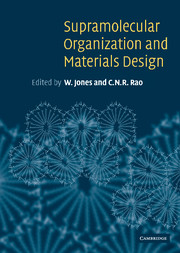Book contents
- Frontmatter
- Contents
- List of contributors
- Preface
- 1 Assembly and mineralization processes in biomineralization: strategies for forming biological composite materials
- 2 Mesoscale materials synthesis and beyond
- 3 Towards the rational design of zeolite frameworks
- 4 Mesoscale self-assembly: the assembly of micron-and millimeter-sized objects using capillary forces
- 5 Design of amphiphiles for the modulation of catalytic, membranous and gelation properties
- 6 Nanofabrication by the surface sol-gel process and molecular imprinting
- 7 The hierarchy of open-framework structures in metal phosphates and oxalates
- 8 Mesoscale self-assembly of metal nanocrystals into ordered arrays and giant clusters
- 9 Layered double hydroxides as templates for the formation of supramolecular structures
- 10 Molecular machines
- 11 Some aspects of supramolecular design of organic materials
- 12 Controlling crystal architecure in molecular solids: the supramolecular approach
- Index
11 - Some aspects of supramolecular design of organic materials
Published online by Cambridge University Press: 18 December 2009
- Frontmatter
- Contents
- List of contributors
- Preface
- 1 Assembly and mineralization processes in biomineralization: strategies for forming biological composite materials
- 2 Mesoscale materials synthesis and beyond
- 3 Towards the rational design of zeolite frameworks
- 4 Mesoscale self-assembly: the assembly of micron-and millimeter-sized objects using capillary forces
- 5 Design of amphiphiles for the modulation of catalytic, membranous and gelation properties
- 6 Nanofabrication by the surface sol-gel process and molecular imprinting
- 7 The hierarchy of open-framework structures in metal phosphates and oxalates
- 8 Mesoscale self-assembly of metal nanocrystals into ordered arrays and giant clusters
- 9 Layered double hydroxides as templates for the formation of supramolecular structures
- 10 Molecular machines
- 11 Some aspects of supramolecular design of organic materials
- 12 Controlling crystal architecure in molecular solids: the supramolecular approach
- Index
Summary
Introduction
Chambers 21st Century Dictionary defines ‘material’ as ‘any substance out of which something is, or may be, made’ [1]. For the purpose of this chapter a somewhat different statement will be used: any organic substance that may have potential applications will be termed an organic material. Superimposed on this definition we would like to have another constraint: such materials should be supramolecularly synthesizable (i.e. noncovalently assembled from molecular components).
‘Chemistry beyond the molecule’ [2], or supramolecular chemistry as we know it, has evolved over the past three decades, and has now become a hot area of research in chemistry. One of the characteristics of supramolecular chemistry is that the traditional barriers of organic, inorganic, physical and analytical chemistry do not exist here – it is a unique multidisciplinary area in which all areas of chemistry (and some other disciplines) are blended nicely.
Supramolecular chemistry originally developed with the design of receptors for metal ions and small organic molecules (the discovery of crown ethers and synthesis of cryptands, cyclophanes, molecular tweezers, etc.), but has now grown beyond molecular recognition and catalysis. From studies on simple molecular recognition we have learnt how complex molecular species can be designed and built – systems which will not only be useful for understanding molecular interactions, but will also function in a predictable manner. The concept of self-assembly [3, 4] is increasingly being used towards achieving this.
- Type
- Chapter
- Information
- Supramolecular Organization and Materials Design , pp. 363 - 390Publisher: Cambridge University PressPrint publication year: 2001
- 1
- Cited by



